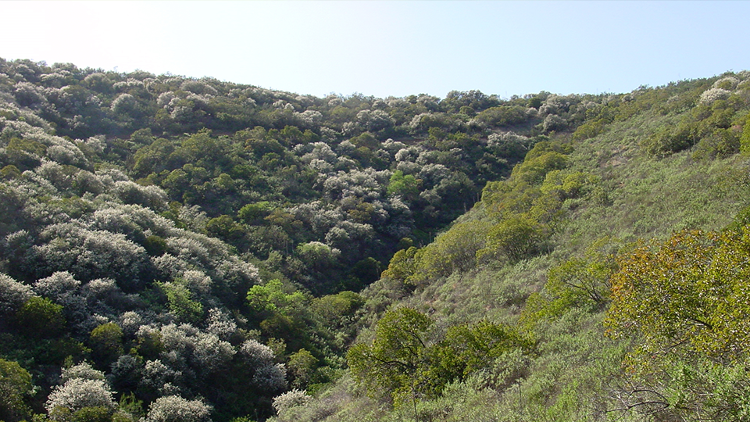The Challenge
With climate change, extreme weather events like droughts and heatwaves have become much more frequent in California. Coastal sage scrub (CSS) is a unique ecosystem native to California, which consists of drought-deciduous plants and evergreen shrubs. CSS is a major shrubland type in the Los Angeles region that plays a central role in the conservation of native biodiversity and as recreational areas. These shrubland ecosystems are relatively well adapted to seasonal drought to survive the hot summer months. However, how they will cope with and respond to intensifying water stress, associated with rising temperatures, under climate change is less clear.
The Solution
The study investigates how long-term water stress impacts the native shrublands at the UCLA Stunt Ranch Santa Monica Mountains Reserve by combining model simulations with field measurements. Researchers evaluate how water use efficiency changes with rising temperatures at both species level and ecosystem level. A shrubland monitoring system will be developed as part of this project, which can be duplicated and deployed to other field sites regionally and beyond.
Results
Water use efficiency decreases with temperature across all species of shrubs, but some species are less affected by increasing atmospheric water stress relative to others. For instance, laurel sumac (Malosma laurina) have a higher level of tolerance to water stress than purple sage (Salvia leucophylla), though both species are evergreen shrubs part of CSS.
Next Steps
The scope of research was later expanded to include chaparral communities in addition to California’s CSS. Findings comparing the two plant communities in terms of their responses to drought were published by the principal investigator Ulrike Seibt and other UCLA researchers in February 2020.
Additional Studies That Build on This Research
Pezner, A. K., Pivovaroff, A. L., Sun, W., Sharifi, M. R., Rundel, P. W., & Seibt, U. (2020). Plant Functional Traits Predict the Drought Response of Native California Plant Species. International Journal of Plant Sciences, 181(2), 256-265. doi:10.1086/70
In this study, researchers found that responses to drought-induced dehydration stress differ between chaparral and CSS communities, and this is due to plant functional traits such as rooting depth and drought tolerance or avoidance strategies. CSS species have a higher sensitivity to and quicker recovery from seasonal drought than chaparral species because of their shallower rooting depths and higher dehydration tolerance.

Topics
Research Team
Ulrike Seibt
Atmospheric & Oceanic Sciences, Physical Sciences
ulli@atmos.ucla.edu
Lawren Sack
Ecology & Evolutionary Biology, Life Sciences
Institute of the Environment & Sustainability
lawrensack@ucla.edu




